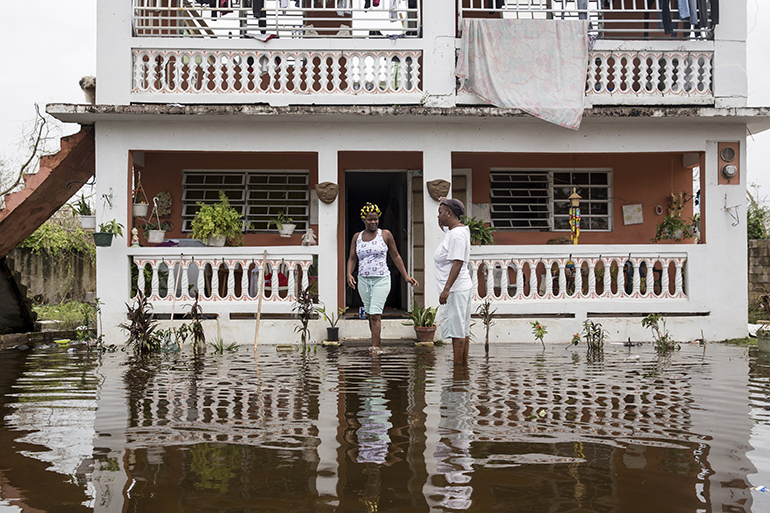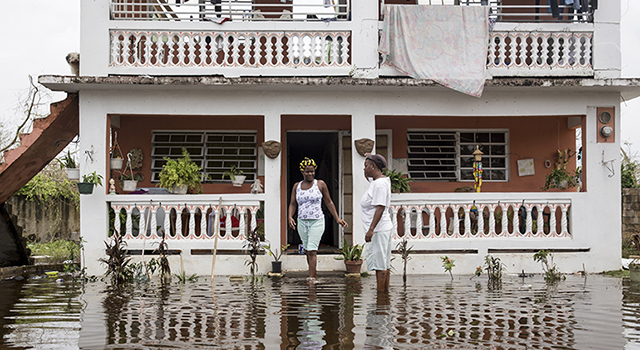By Rocio Granados - La Voz Catolica

Photographer: COURTESY GETTY IMAGES
Residents wade through flood waters at their home days after Hurricane Maria made landfall, on September 22, 2017 in Loiza, Puerto Rico. Many on the island have lost power, running water, and cell phone service after Hurricane Maria, a category 4 hurricane, passed through.
MIAMI | Zorybel González Colón, a Puerto Rican resident of Florida, says she’s mentally prepared to have no communication with her family for at least one month.
“I imagine they’re at home, completely unable to communicate,” said González, who has all her family and friends on the island. She added that she’s worried about them, “but I have to remain calm so they can remain calm.”
Thousands of Puerto Ricans who live outside the island are experiencing the same thing. Hurricane Maria, which ravaged the U.S. commonwealth as a Category 4 storm Sept. 20, has left the island devastated and with no means of communication.
“We’re getting very strong winds; even so we are well, thanks be to Jesus,” were the last words González heard from her family, via text at 6:51 a.m. that Wednesday morning.
González’s parents, her brother, grandparents and uncles decided to wait for the hurricane in their home in Villalba, in the central southern part of the island near Ponce, and about two hours west of Yabucoa, where the hurricane made landfall. Because the house is situated in an elevated area, González does not think her parents experienced flooding, although nearby communities did.
It is believed the southern part received the worst impact from the storm, although Maria traveled over the entirety of the island.
Puerto Ricans’ fears for their relatives are understandable given that the images posted on social media � which has played a preeminent role in providing the most up-to-date news � depict a catastrophic situation.
“It is the worst hurricane in the history of Puerto Rico,” said the island’s governor, Ricardo Roselló, after the eye of hurricane, with winds clocked at 155 miles per hour, entered Puerto Rican territory at approximately 6 a.m. Sept. 20.
The island’s nearly 3.5 million residents lost all means of communication and many towns were totally isolated. The hurricane unleashed flooding caused by the rising rivers, vast damages to homes and public buildings, fallen trees, the destruction of the power grid throughout the country and the loss of drinking water. Looting also was reported, leading the governor to impose a curfew. Flash flood warnings continued days later.
Roselló said the post-Maria process of rebuilding and recovery would take a long time. He said the first priority would be to save lives and then reopen the ports and airports so that aid could flow in, health services could be restored and the work of rebuilding the infrastructure could begin.
The San Juan airport reopened Sept. 24 for limited commercial flights. The Puerto Rican community in Florida, in the meantime, embarked on a massive effort of collecting relief supplies � water, canned foods, generators, battery-operated fans � to send to the island.
The day after the storm, the U.S. government declared 54 Puerto Rican municipalities as disaster zones � not the entire nation, as Roselló had requested. FEMA in the Caribbean mobilized to help in the recovery process.
According to the Puerto Rican newspaper El Nuevo Día (new day), the president of the agency that regulates telecommunications on the island, Sandra Torres, said restoring land and cellular lines would be a priority, for security reasons.
She said telecommunications was second in the list of priorities, after clearing the roads. She noted that only about 25 percent of the cell tower antennas were working and communication was intermittent, depending on the company providing the service.
Puerto Rico has a massive debt of $120 billion, and the cost of the damages caused by Maria has yet to be calculated. Some legislators have asked for a financial bailout of the island, but that would require an act of Congress.
Hurricane Maria made history on the island, which had not faced a Category 4 or 5 storm since 1928. Maria also arrived just two weeks after Irma, the most powerful Atlantic hurricane in history, brushed Puerto Rico’s northern coast with winds of 105 miles per hour, also causing great damage.
Maria also battered the islands of Dominica, Guadalupe and the U.S. Virgin Islands, and it lashed the coast of the Dominican Republic, leaving about 140,000 people without electricity, destroying at least 1,000 homes that had already been affected by Irma, and forcing the evacuation of 17,000 people.
On Sept. 22, Maria continued its path through the Caribbean, hitting the Turks and Caicos and the Bahamas with Category 3 winds of 125 miles an hour.
According to figures provided by the Puerto Rican government as of Sept. 25, Maria was responsible for six confirmed deaths in Puerto Rico. Additionally, about 15,000 Puerto Ricans are living in shelters.
González said she was able to communicate during the storm with friends who live in San Juan, where the internet and cell phones were working in some areas. While waiting to communicate with her family, she is considering traveling to the island with a group of friends. She is also waiting for the airport in Ponce to open. From there, it’s a one- to two-mile walk to her family’s home in Villalba.
WHERE TO GET INFORMATION
The webpage of the Puerto Rico Federal Affairs Administration is providing the following contact information to help people get in touch with their relatives on the island.
- For general information and help: 202-800-3133; or [email protected].
- The webpage is http://prfaa.pr.gov/.
The Univision network has developed a map of Puerto Rico where people can click to view the latest information about their home towns or get in contact with their families. The shortened link is: http://bit.ly/2yoFD5b.

